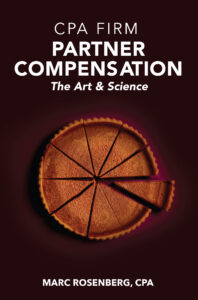12 Practice Management Blunders: Part 1 of 3
![]() Marc Rosenberg, CPA
Marc Rosenberg, CPA![]() Kristen Rampe, CPA / May 11, 2022
Kristen Rampe, CPA / May 11, 2022
Providing consulting services to CPA firms is a great job. We get to work with dozens of successful, hard-working firms every year, which puts us in the enviable position of observing best practices and practices that are, well, not so good. The latter enables us to share with firms how to make changes that will improve their practices.
We see 12 practices over and over again that are either ineffective, poor choices or misguided. In this three-part blog series, we share these practice management blunders with you. This is Part 1.
1. Using Formulas to Allocate Partner Income
Partner groups are lured by the supposed benefits of using formulas. All of them are misguided.
Fallacy #1: “Accountants love numbers. They are naturally attracted to compensation formulas because numbers speak for themselves. No arguments with formulas.”
Fallacy debunked: Most of our partner compensation work is moving firms off formulas to a subjective system such as comp committee or MP-decides. Why? Two reasons:
- Contrary to the belief that formulas prevent arguments, nothing could be further from the truth. Arguments arise over what the various formula factors should be, how credit should be split between two partners involved with the same client, how the factors are weighted and how they are measured.
- Second, formulas fail to recognize performance by partners in intangible areas such as firm management, teamwork, loyalty, work ethic, mentoring staff and many more. As firms grow beyond three or four partners, they begin to realize that these intangible contributions are critical to the firm’s success and profitability.
Fallacy #2: “Operating a CPA firm is simple. You bring in business, perform the work, bill it out and keep clients happy. Period. The more that partners do this, the more we earn. Therefore, we want to incentivize our partners to excel at production.”
Fallacy debunked: Running a CPA firm is not simple. Yes, basic finding, minding and grinding is important. But so is managing the firm effectively—developing and mentoring staff, working in a team, demonstrating loyalty, adhering to the firm’s core values, being a good corporate citizen and achieving SMART goals, among many other factors.
There is a familiar saying: “You get what you reward.” In other words, if partners are not incentivized to perform in these intangible areas, then partners are less likely to strive for excellence in these intangible areas.
Finally, let us share with you a statement we have heard several firms make: “It’s the duty of all partners to perform in the intangible areas. That’s why they are partners. We don’t have to compensate for intangibles because, as partners, we all do these things.” While this may work initially with a two-partner founder-led firm, as the firm evolves and new partners join, intangible contributions are not the same. Our years of consulting with CPA firms have shown us that partners’ performance in these intangible areas varies from excellent to weak. This variability needs to be factored into a firm’s compensation system.
Fallacy #3: “We understand that intangibles are important and should be compensated—but how can they be fairly and objectively measured? Because evaluating partners’ intangible skills may have a subjective element, we are fearful that this will cause endless arguments.”
Fallacy debunked: There is no question that intangibles are harder to measure than traditional partner production. But it can be done and is done by thousands of CPA firms. Yes, the subjectivity involved in evaluating intangibles could cause partners to feel the system is biased and unfair. But at the heart of any subjective system is this: “If you don’t trust the judges, the system won’t work. Period.” Whether it’s a managing partner deciding compensation or a comp committee allocating income, the partners must trust the decision-makers to be objective and fair. If this trust doesn’t exist, then it may be difficult to provide for intangibles as a partner compensation factor.
Fallacy #4: “Many firms use formulas, and we should do what other firms do. These firms can’t be all wrong.”
Fallacy debunked: As the adage goes: “If everyone else jumped off a tall building, would you?” Many common practices are not best practices simply because other firms are doing it. Using formulas to allocate partner income is one of them.
CPA Partner Compensation: The Art and the Science explains ►Partner comp 101 ► the 12 systems used by all firms ►how to design your firm’s system ►open vs. closed systems ►the role of “book of business” ►differences between large and small firms’ systems ► the MP’s compensation ► trends and controversies and ►overall best practices.
2. Not Having a Partner Buyout Plan in Place
The main reason for this oversight is not because the partners don’t believe that a partner’s interest in the firm should be redeemed upon leaving the firm. Instead, it’s because the partners can’t agree on how the buyout amount should be computed. It could also be that a number of partners feel that certain other partners are not worth a handsome buyout.
We’ll slightly refute the adage about jumping off tall buildings by sharing this with you: 88% of all CPA firms have a partner buyout provision in their partner agreement. This jumps to 95% for firms with five or more partners. This doesn’t mean that firms should mindlessly do what everyone else does. Instead, it’s proof that as challenging as it is to agree on the 30 or so major provisions of an effective buyout plan, it can be done. Often, partner groups cannot craft the plan themselves because of the sensitivity of the issues. Engaging an outside consultant can steer the firm through this storm.
3. The Managing Partner Has a Large Client Base
Firms often find that the person who is the best rainmaker or client handler is also the most credible and respected partner. So guess what: the rainmaker is often the managing partner. (This doesn’t always mean that the rainmaker has management skills, but that’s a subject for another time.) In many instances, MPs in their early years were not involved in management and focused entirely on building and serving a client base. Upon being named MP, they sort of grew into the position. As a result, in many cases, the new MP has a substantial client base to manage and works 1,100 to 1,500 billable hours a year.
Managing a CPA firm is a big job. It may not be a full-time job, but it does require the MP to devote a substantial amount of time to the position. It simply cannot be performed well if (a) there is not enough time to do the job, and (b) MPs are unable to focus on MP duties because they are heavily burdened by client responsibilities, which always seem to take priority over internal functions. To be effective, the MP’s #1 client should be the firm.
Depending on firm size, it takes 500 to 1,000 hours to properly manage a firm. To avoid the MP working over 3,000 hours a year, the MP’s client responsibilities need to be significantly reduced.
Stay tuned for Part 2 where we explore even more practice management blunders.

CPA Firm Partner Compensation: The Art and Science
No one partner compensation system applies to all firms. Both subjective judgment and quantifiable methods and tactics must be employed to result in an outcome that satisfies the partners and is perceived as fair. Tailor your partner comp system specifically for your firm: here's how.
Learn More